We at Crack4sure are committed to giving students who are preparing for the Oracle 1z0-062 Exam the most current and reliable questions . To help people study, we've made some of our Oracle Database 12c: Installation and Administration exam materials available for free to everyone. You can take the Free 1z0-062 Practice Test as many times as you want. The answers to the practice questions are given, and each answer is explained.
Examine the resources consumed by a database instance whose current Resource Manager plan is displayed.
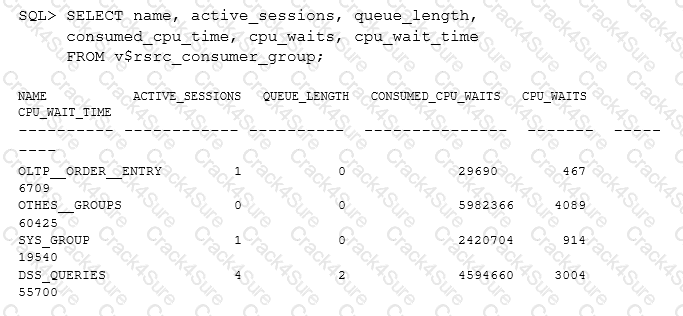
Which two statements are true? (Choose two.)
Which two statements are true about Oracle Managed Files (OMF)? (Choose two.)
Which files must you copy from the Oracle home of the database that is being upgraded to the new Oracle home for Oracle Database 12c? (Choose three.)
Which three statements are true about checkpointing? (Choose three.)
A warehouse fact table in your Oracle 12c Database is range-partitioned by month and accessed frequently with queries that span multiple partitions
The table has a local prefixed, range partitioned index.
Some of these queries access very few rows in some partitions and all the rows in other partitions, but these queries still perform a full scan for all accessed partitions.
This commonly occurs when the range of dates begins at the end of a month or ends close to the start of a month.
You want an execution plan to be generated that uses indexed access when only a few rows are accessed from a segment, while still allowing full scans for segments where many rows are returned.
Which three methods could transparently help to achieve this result? (Choose three.)
Which three operations can be performed as multipartition operations in Oracle? (Choose three.)
Identify two correct statements about multitenant architectures.
A database instance is started by using an SPFILE. The database is configured in ARCHIVELOG mode and the control file autobackup is configured. Daily full database backups are performed by using RMAN.
You lost all control files due to media failure.
Given the steps to recover from the error in random order:
1. Shut down the instance, if it is not already down.
2. Restore the control file from autobackup to a new location.
3. Start the database instance to NOMOUNT state.
4. Recover the database to the point of failure of the control file.
5. Open the database with the RESETLOGS option.
6. Mount the database.
7. Update the SPFILE with the new location of the control file by using the ALTER SYSTEM command.
Identify the correct sequence of the required steps.
In your multitenant container database (CDB) containing same pluggable databases (PDBs), you execute the following commands in the root container:

Which two statements are true? (Choose two.)
Examine the details of the Top 5 Timed Events in the following Automatic Workloads Repository (AWR) report:

What are three possible causes for the latch-related wait events?
The user SCOTT owns the CUST table that is placed in the SALES tablespace. The user SCOTT opens a session and executes commands as follows:
SQL> INSERT INTO cust VALUES(101, 'JACK');
1 row created.
SQL> INSERT INTO cust VALUES(102, 'SMITH');
1 row created.
As a DBA, you execute the following command from another session:
ALTER TABLESPACE sales READ ONLY;
Which statement is true regarding the effect of this command on the transaction in Scott's session?
In order to exploit some new storage tiers that have been provisioned by a storage administrator, the partitions of a large heap table must be moved to other tablespaces in your Oracle 12c database?
Both local and global partitioned B-tree Indexes are defined on the table.
A high volume of transactions access the table during the day and a medium volume of transactions access it at night and during weekends.
Minimal disrupt ion to availability is required.
Which three statements are true about this requirement? (Choose three.)
Which three statements are true about automated maintenance tasks? (Choose three.)
Which two statements are true about the Automatic Database Diagnostic Monitor (ADDM)? (Choose two.)
Which three statements are true about the Pre-Upgrade Information Tool? (Choose three.)
Flashback is enabled for your multitenant container database (CDB), which contains two pluggable database (PDBs). A local user was accidently dropped from one of the PDBs.
You want to flash back the PDB to the time before the local user was dropped. You connect to the CDB and execute the following commands:
SQL > SHUTDOWN IMMEDIATE
SQL > STARTUP MOUNT
SQL > FLASHBACK DATABASE to TIME “TO_DATE (‘08/20/12’ , ‘MM/DD/YY’)”;
Examine following commands:
1. ALTER PLUGGABLE DATABASE ALL OPEN;
2. ALTER DATABASE OPEN;
3. ALTER DATABASE OPEN RESETLOGS;
Which command or commands should you execute next to allow updates to the flashback back schema?
Which three statements are true when the listener handles connection requests to an Oracle 12c database instance with multithreaded architecture enabled In UNIX? (Choose three.)
Which three activities are supported by the Data Recovery Advisor? (Choose three.)
You conned using SQL Plus to the root container of a multitenant container database (CDB) with SYSDBA privilege.
The CDB has several pluggable databases (PDBs) open in the read/write mode.
There are ongoing transactions in both the CDB and PDBs.
What happens alter issuing the SHUTDOWN TRANSACTIONAL statement?
A senior DBA asked you to execute the following command to improve performance:
SQL> ALTER TABLE subscribe log STORAGE (BUFFER_POOL recycle);
You checked the data in the SUBSCRIBE_LOG table and found that it is a large table containing one million rows.
What could be a reason for this recommendation?
Which three factors influence the optimizer's choice of an execution plan? (Choose three.)
Which statement is true regarding the startup of a database instance?
You execute the commands:
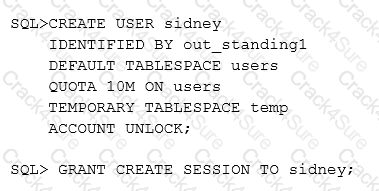
Which two statements are true? (Choose two.)
You notice a performance change in your production Oracle 12c database. You want to know which change caused this performance difference.
Which method or feature should you use?
You performed an incremental level 0 backup of a database:
RMAN > BACKUP INCREMENTAL LEVEL 0 DATABASE;
To enable block change tracking after the incremental level 0 backup, you issued this command:
SQL > ALTER DATABASE ENABLE BLOCK CHANGE TRACKING USING FILE
‘ /mydir/rman_change_track.f’;
To perform an incremental level 1 cumulative backup, you issued this command:
RMAN> BACKUP INCREMENTAL LEVEL 1 CUMULATIVE DATABASE;
Which three statements are true? (Choose three.)
Which two statements are true about using SQL*Loader? (Choose two.)
You want to load data from a large file into your database without causing an overhead on the SGA.
Which tool would you use.
Which two categories of segments are analyzed by the Automatic Segment Advisor? (Choose two.)
Because of a logical corruption in the EMPLOYES tables, you want to perform Tablespace Point-in-Time Recovery (TSPITR) to recover the table. Before you started the TSPITR process, you queried the TS_PITR_CHECK view and you realized that the table has a referential constraint with DEPARTMENTS that exists in another tablespace, MASTERTBS. Which two actions will permit the TSPITR to work? (Choose two.)
Your database supports a Decision Support System (DSS) workload that involves the execution of complex queries. Currently, the database is running with peak workload. You want to analyze some of the most resource-intensive statements cached in the library cache.
What must you run to receive recommendations on the efficient use of indexes and materialized views to improve query performance?
The HR user owns the BONUSES table. HR grants privileges to the user TOM by using the command:
SQL> GRANT SELECT ON bonuses TO tom WITH GRANT OPTION;
TOM then executes this command to grant privileges to the user JIM:
SQL> GRANT SELET ON hr.bonuses TO jim;
Which statement is true?
Examine these statements:
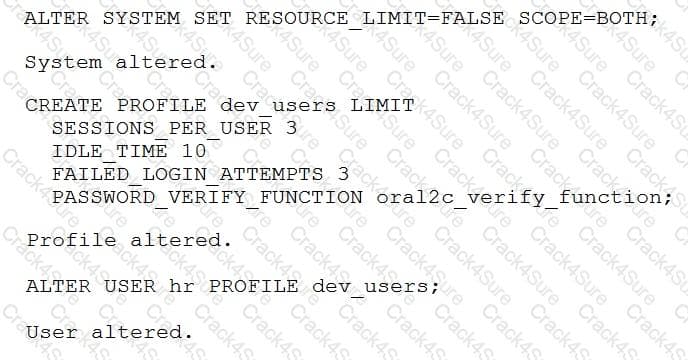
Which three are true about the effects of executing these statements? (Choose three.)
Identify three situations in which messages are written to the alert log file. (Choose three.)
Your database is in NOARCHIVELOG mode. You want to enable archiving for the database.
Examine the steps:
1. Execute the ALTER DATABASE ARCHIVELOG command.
2. Execute SHUTDOWN IMMEDIATE.
3. Execute STARTUP MOUNT.
4. Set the DB_RECOVERY_FILE_DEST parameter to $ORACLE_HOME/dbs/.
5. Execute STARTUP NOMOUNT.
6. Open the database.
Identify the required steps in the correct sequence.
The schema SALES exists in two databases, ORCL1 and ORCL2, and has the same password, SALES123.
User SALES has CREATE DATABASE LINK and CREATE SESSION privileges on both databases.
Examine these commands:
Conn SALES/SALES123
CREATE DATABASE LINK orcl2 USING 'orcl2';
What is the outcome of executing these commands in the ORCL1 database?
Which three are activities performed by SMON? (Choose three.)
In one of your databases, unified auditing is enabled and an SH.SALES table exists.
You can successfully execute these commands:

Which statement is true about SALES_POL?
Which three statements are true about Database Resource Manager? (Choose three.)
Which two statements are true about initialization parameter files? (Choose two.)
You install “Oracle Grid Infrastructure for a standalone server” on a host on which the ORCL1 and ORCL2 databases both have their instances running.
Which two statements are true? (Choose two.)
You want to create a table, DAILY_ORDERS, for an OLTP application, where data should be compressed during both direct-path INSERT and conventional DML. The table will also be used for queries.
Which compression option should be used?
The HR.DEPARTMENTS table is the parent of the HR.EMPLOYEES table. The EMPLOYEES.DEPARTMENT_ID column has a foreign key constraint with the ON DELETE CASCADE option that refers to the DEPARTMENTS.DEPARTMENT_ID column. An index exists on the DEPARTMENTS.DEPARTMENT_ID column. A transaction deletes a primary key in the DEPARTMENTS table, which has child rows in the EMPLOYEES table.
Which statement is true?
You are about to plug a multi-terabyte non-CDB into an existing multitenant container database (CDB).
The characteristics of the non-CDB are as follows:
– Version: Oracle Database 11g Release 2 (11.2.0.2.0) 64-bit
– Character set: AL32UTF8
– National character set: AL16UTF16
– O/S: Oracle Linux 6 64-bit
The characteristics of the CDB are as follows:
– Version: Oracle Database 12c Release 1 64-bit
– Character Set: AL32UTF8
– National character set: AL16UTF16
– O/S: Oracle Linux 6 64-bit
Which technique should you use to minimize down time while plugging this non-CDB into the CDB?
Identify three valid options for adding a pluggable database (PDB) to an existing multitenant container database (CDB).
Examine the parameters for your database instance:

You execute the following command:
SQL> ALTER TABLESPACE undotbs1 RETENTION NOGUARANTEE;
Which statement is true in this scenario?
Examine the parameter for your database instance:

You generated the execution plan for the following query in the plan table and noticed that the nested loop join was done. After actual execution of the query, you notice that the hash join was done in the execution plan:
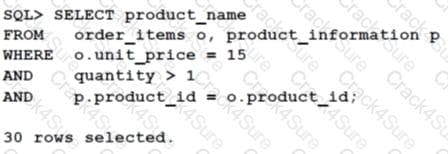
Identify the reason why the optimizer chose different execution plans.
Which three statements are true concerning the multitenant architecture? (Choose three.)
Examine the parameters for a database instance:

Which two statements are true? (Choose two.)
Identify two situations in which the alert log file is updated.
You are connected using SQL* Plus to a multitenant container database (CDB) with SYSDBA privileges and execute the following sequence statements:
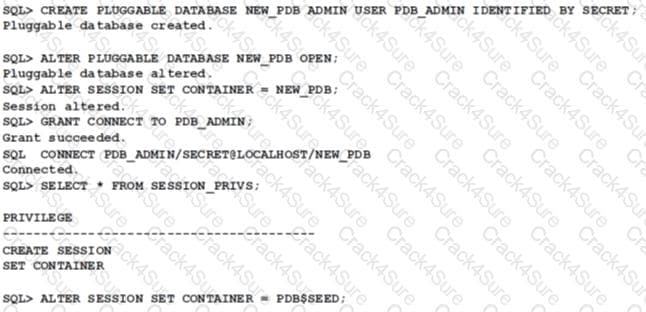
What is the result of the last SET CONTAINER statement and why is it so?
You plan to implement the distributed database system in your company. You invoke Database Configuration Assistant (DBCA) to create a database on the server. During the installation, DBCA prompts you to specify the Global Database Name.
What must this name be made up of?